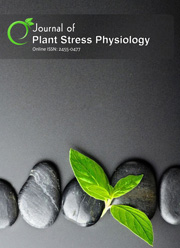Salt stress mitigation by salicylic acid in wheat for food security in coastal area of Bangladesh
DOI:
https://doi.org/10.25081/jpsp.2018.v4.3424Abstract
Salt stress has a large impact on controlling the plant growth and development. The present study was conducted to examine the role of salicylic acid on alleviation of salt stress in wheat. In this experiment, the treatment consisted of four different salinity levels viz. S0 = without salt (control), S1 = 2.8 g NaCl kg-1 soil ? 3-4 dSm-1, S2 = 6.0 g NaCl kg-1 soil ? 7-8 dSm-1, S3 = 9.0 g NaCl kg-1 soil ? 11-12 dSm-1 and three different levels of salicylic acid (SA) viz. A0 = 0 mM, A1= 0.2 mM and A2 = 0.4 mM. It was done by using two factors Randomized Complete Block Design (RCBD) with four replications. The total treatment combinations were 12 (4x3). Results of the experiment showed a significant dissimilarity among the treatments in respect of the major parameters. Yield of wheat were exaggerated by different levels of salinity. The higher levels of salinity showed greater reduction of yield. The highest grain yields (1.55 tha-1) were recorded at S0A2 (Without Salt + 0.4 mM salicylic acid) treatment combination which did not show any difference with S0A0 (Without Salt+ Without SA) and S0A1 (Without Salt + 0.2 mM SA). But the grain yield was gradually decreased with the increasing level of salinity. The application of salicylic acid increased the grain yield differently according to the levels of salinity. The minimum grain yields were found 1.14 t ha-1, 1.07 tha-1 and 0.26 t ha-1 at 3-4 dSm-1, 7-8 dSm-1 and 11-12 dSm-1 NaCl respectively. These yields were increased with SA (0.4 mM) from 1.14 to 1.32 tha-1, 1.07 to 1.14 tha-1 and 0.26 to 0.31 tha-1 at 3-4 dSm-1, 7-8 dSm-1 and 11-12 dSm-1 NaCl respectively. These results suggest that salicylic acid can alleviate the detrimental impacts of salinity and increase the grain yield of wheat.



 .
.